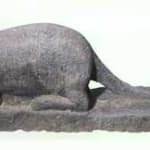Large Sculpture Of A Rat, 960 CE - 1279 CE
Granite
19.25
H.525
This mounted stone carving of a rat is representative of the craftsmanship of Song Dynasty carvers as production for certain auspicious animals, guardians, and Buddhas increased in tandem with the...
This mounted stone carving of a rat is representative of the craftsmanship of Song Dynasty carvers as production for certain auspicious animals, guardians, and Buddhas increased in tandem with the trend to aggrandize places of worship or memorial halls. With the massiveness of stone slats, artisans could create awe-inspiring dragons and guardians to stand at the entrances of tomb complexes, palaces and temples. The preference for a rock medium is also tied to the belief that rock contains a positive energy that could be transferred to the carved formation endowing it with a strong life force. Crouched with legs bent and tail stretched out, the rat's face projects over one end of the mount. Its ears stand up, and its gently carved features give a countenance of solemnity. The rat is the first of the twelve animals that makes up the Twelve Terrestrial Branches, and is an emblem of timidity and meanness. It is also regarded as a symbol of industry and prosperity on account of its ability for locating, acquiring and hoarding abundant supplies of food. Among the various structures that were adorned with large stone carvings, tombs attracted special categories of sculpture: pillars at the entrance and large carvings of animals and men. Stone pieces from the Song Dynasty tended to depict the real world. It is likely that this carving of rat could have been placed near a tomb complex.
Literature
V17



